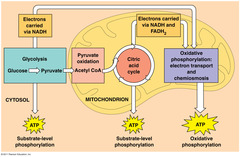Cellular Respiration and Fermentation
| 6285623292 | Fermentation | anaerobic process that produces little ATP, includes glycolysis, and restores NAD+ |  | 0 |
| 6285623293 | Aerobic Respiration | the catabolic pathway which requires oxygen and occurs in cytoplasm and mitochondria |  | 1 |
| 6285623294 | Anaerobic Respiration | the catabolic pathway which does not require oxygen and occurs only in the cytoplasm |  | 2 |
| 6285623295 | Oxidation | loss of electrons from atoms of a substance |  | 3 |
| 6285623296 | Reduction | addition of electrons to atoms of a substance |  | 4 |
| 6285623297 | Reducing Agent | electron donor in a redox reaction |  | 5 |
| 6285623298 | Oxidizing Agent | electron acceptor in a redox reaction |  | 6 |
| 6285623299 | NAD+ | electron carrier used in cellular respiration to transfer electrons from Kreb's cycle to ETC |  | 7 |
| 6285623300 | Electron Transport Chain (ETC) | (1) transfer of electrons from glucose via NADH/FADH2 to transmembrane proteins and subsequently using their high energy to pump protons to intermembrane space in mitochondria or thylakoid space in chloroplasts |  | 8 |
| 6285623301 | Citric Acid (Kreb's) Cycle | (B) 2nd step of cellular respiration that breaks down AcetylCoA to 2 carbon dioxide, 1 ATP, 3NADH, and 1 FADH2 molecules in mitochondrial matrix (aerobic) |  | 9 |
| 6285623302 | Glycolysis | (A) 1st step of cellular respiration that splits glucose into 2 molecules of pyruvic acid and 2 ATPs (anaerobic, catabolic/exergonic) |  | 10 |
| 6285623303 | Pi (not π) | inorganic phosphate |  | 11 |
| 6285623304 | Oxidative Phosphorylation | (3) synthesis of ATP from ADP and Pi at ATP synthase using energy from glucose electrons which are ultimately transferred to oxygen (final electron acceptor) using ETC in mitochondrial (aerobic) |  | 12 |
| 6285623305 | Substrate Level Phosphorylation | synthesis of ATP by transferring a phosphate group directly to ADP using an enzyme |  | 13 |
| 6285623306 | Chemiosmosis | (3) movement of protons down their concentration gradient coupled to ATP synthesis |  | 14 |
| 6285623307 | Proton Motive Force | potential energy stored in form of an electrochemical gradient generated by pumping hydrogen ions across membranes during ETC |  | 15 |
| 6285623308 | Alcohol Fermentation | conversion of pyruvate to carbon dioxide and 2-carbon compound in absence of oxygen to regenerate NAD+ needed for glycolysis (in yeast) |  | 16 |
| 6285623309 | Lactic Acid Fermentation | conversion of pyruvate to 3-carbon compound in absence of oxygen to regenerate NAD+ needed for glycolysis (in our muscles) |  | 17 |
| 6285623310 | Obligate Anaerobes | organisms that can only survive WITHOUT oxygen |  | 18 |
| 6285623311 | Redox | electron transfer reactions that occur together and in which one chemical is oxidized and the other reduced |  | 19 |
| 6285623312 | Formation of acetyl CoA | metabolic link between glycolysis and aerobic respiration |  | 20 |
| 6285623313 | Cellular Respiration | exergonic process that includes 3 steps and releases energy (ATP) by breaking down glucose and other molecules in presence of oxygen |  | 21 |
| 6285623314 | Cytochromes | iron-containing proteins that play key role in electron transport chains in mitochondria, chloroplasts, and cell membranes of prokaryotes |  | 22 |
| 6285623315 | ATP Synthase | enzyme in mitochondrial cristae and chloroplast thylakoids that uses energy of proton gradient to add a phosphate group to ADP and so form ATP |  | 23 |
| 6285623316 | Facultative Anaerobes | organisms that can survive with OR without oxygen |  | 24 |
| 6285623317 | Kinases/Phosphatases | enzymes that transfer phosphate groups |  | 25 |

